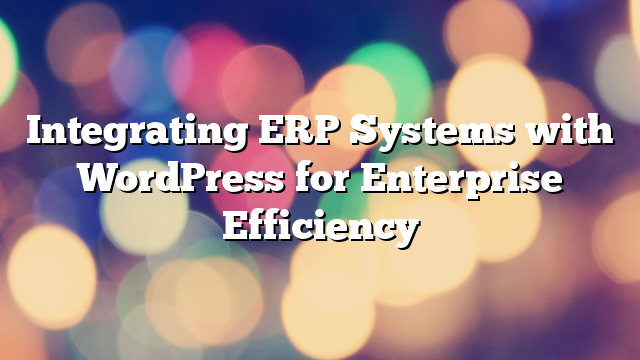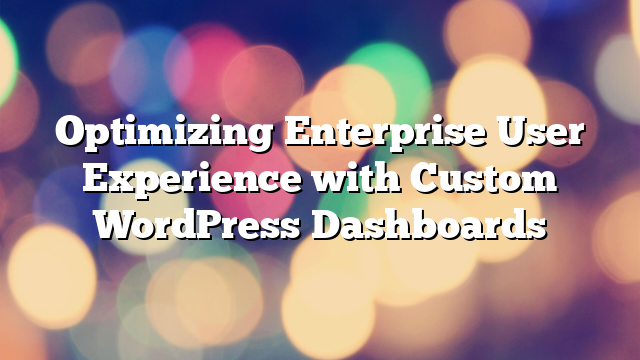The Benefits of Using Headless WordPress for Enterprise-Level Projects
28.10.2024

As enterprises increasingly prioritize performance, flexibility, and scalability in their digital platforms, many are turning to headless WordPress as a solution for building complex, dynamic websites. Headless WordPress separates the back-end content management from the front-end presentation layer, providing greater control over how content is delivered across various channels. For enterprise-level projects, this approach offers a range of benefits, from faster performance to enhanced security. In this article, we’ll explore the key advantages of using headless WordPress for large-scale projects.
What Is Headless WordPress?
In a traditional WordPress setup, the platform handles both the content management and front-end display of a website. WordPress themes dictate how content is presented to users, and all content requests are processed through the WordPress core.
However, in a headless WordPress architecture, the content management system (CMS) is decoupled from the front-end. This means WordPress is used strictly as a back-end CMS, where content is created and stored, while a separate front-end framework (such as Next.js or React) handles how the content is displayed to users. The two systems communicate via APIs, typically using WordPress’s REST API or GraphQL.
This separation allows developers to use modern JavaScript frameworks to build highly customizable, performant front-end experiences, while still leveraging WordPress’s robust content management features on the back end.
Advantages of Headless WordPress for Enterprise Projects
1. Improved Performance and Speed
One of the biggest advantages of headless WordPress is improved website performance. Since the front-end is decoupled from WordPress, developers can use static site generators or client-side rendering techniques to serve pre-built pages that load much faster than traditional dynamic WordPress sites.
Headless WordPress also allows for Content Delivery Network (CDN) integration, where static assets are served from edge locations closer to the user. This significantly reduces load times, especially for global websites with a distributed audience.
For enterprises, faster loading times lead to better user experiences, improved SEO rankings, and higher conversion rates—key factors in maintaining a competitive edge.
2. Enhanced Flexibility in Front-End Development
Traditional WordPress limits developers to PHP-based themes, which may not offer the flexibility or modern development practices that many enterprises require. With headless WordPress, enterprises can use popular JavaScript frameworks such as React, Next.js, or Vue.js to build completely custom front-end experiences.
This decoupled approach gives developers more creative freedom and the ability to tailor the front-end to meet the specific needs of the enterprise. For example, complex web applications, single-page apps (SPAs), or progressive web apps (PWAs) can be built to deliver highly interactive user experiences that would be difficult to achieve using standard WordPress themes.
3. Omnichannel Content Delivery
In today’s digital landscape, enterprises need to deliver content across multiple platforms and devices, including mobile apps, smart devices, and even voice assistants. Headless WordPress makes it easier to implement an omnichannel content strategy by allowing content to be distributed through APIs to any number of channels.
With headless WordPress, the content stored in the CMS can be delivered to websites, mobile apps, social media platforms, and other digital touchpoints without needing to be restructured or reformatted. This provides a more efficient and cohesive content distribution strategy, ensuring that the brand’s message remains consistent across all platforms.
4. Scalability for High-Traffic Websites
Enterprises often deal with large volumes of traffic, especially during events such as product launches, marketing campaigns, or seasonal sales. A headless WordPress architecture is more scalable than traditional WordPress, as it offloads much of the front-end processing to external systems or CDNs.
This approach allows enterprises to scale their websites without overburdening the WordPress back-end, as the front-end is handled separately. Moreover, headless setups are more easily optimized for handling high traffic loads, resulting in better performance during peak times and reducing the risk of website crashes.
5. Improved Security
Decoupling WordPress from the front-end also improves security, as it limits the exposure of the WordPress back-end to potential attacks. Since the front-end does not interact directly with the WordPress server, it becomes harder for hackers to exploit vulnerabilities such as SQL injections or cross-site scripting (XSS).
Additionally, headless WordPress sites can employ server-side authentication for API requests, further enhancing security by only allowing trusted sources to access the WordPress back-end. This layered security approach is particularly beneficial for enterprises handling sensitive customer data or proprietary information.
6. Custom Workflows and Content Management
Headless WordPress offers enterprises greater flexibility in managing their content workflows. While the traditional WordPress interface remains for content creators and editors, the decoupled architecture allows for custom workflows tailored to the needs of different teams.
For example, content teams can continue to use the familiar WordPress editor to create and manage content, while development teams can build and deploy custom front-end applications. This separation ensures that each team can work independently without disrupting the other, leading to more efficient collaboration and faster project delivery.
Challenges of Headless WordPress
While headless WordPress offers many advantages for enterprises, it does come with some challenges:
- Increased complexity: A headless setup requires more technical expertise, as developers need to manage both the back-end WordPress instance and the front-end application. This can result in higher development costs and longer project timelines.
- Plugin limitations: Many WordPress plugins are designed for traditional setups, and may not work as expected in a headless environment. Enterprises may need to invest in custom development to achieve certain functionalities.
- Maintenance overhead: Managing two separate systems (WordPress back-end and front-end frameworks) requires more maintenance, especially when updates or security patches are needed for both environments.
Is Headless WordPress Right for Your Enterprise?
Headless WordPress is an excellent choice for enterprises that require more flexibility, scalability, and performance from their websites. It is particularly suited for businesses with complex content needs, large volumes of traffic, or a need to deliver content across multiple platforms.
However, the increased complexity and development costs associated with headless WordPress may not be necessary for every enterprise. Organizations with more straightforward website requirements may find that a traditional WordPress setup meets their needs without the added overhead of managing a headless architecture.
If you’re considering implementing a headless WordPress solution for your enterprise, contact AllWebDev for expert guidance on how to maximize the benefits of this modern approach to web development.



